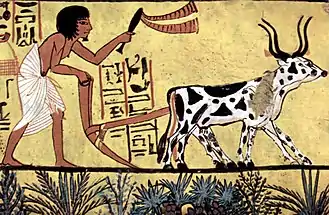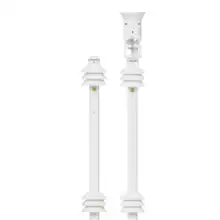| Agriculture |
|---|
 |
|
|
Agricultural technology or agrotechnology (abbreviated agtech, agritech, AgriTech, or agrotech) is the use of technology in agriculture, horticulture, and aquaculture with the aim of improving yield, efficiency, and profitability. Agricultural technology can be products, services or applications derived from agriculture that improve various input/output processes.[1][2]
Advances in agricultural science, agronomy, and agricultural engineering have led to applied developments in agricultural technology.[3][4]
History
The history of agriculture has been shaped by technological advances. Agricultural technology dates back thousands of years. Historians have described a number of agricultural revolutions, which identify major shifts in agricultural practice and productivity. These revolutions have been closely connected to technological improvements.
Around 10,000 years ago, the Neolithic Revolution catalyzed an epochal transformation. Humanity transitioned from nomadic hunter-gatherer societies to stable agricultural communities. This transition bore witness to the domestication of vital plants and animals, including wheat, barley, and livestock, fundamentally altering the agricultural landscape. The surplus food production that ensued fueled population growth and laid the cornerstone for nascent civilizations. Irrigation technology was developed independently by a number of different cultures, with the earliest known examples dated to the 6th millennium BCE in Khuzistan in the south-west of present-day Iran.[5][6] The ancient Egyptian use of the Nile River's flooding, marked another significant advancement.
The Roman era ushered in notable contributions to agricultural technology. The Romans introduced innovative implements, such as the Roman plough, a notable refinement in soil cultivation. In tandem, they compiled comprehensive agricultural manuals like "De Re Rustica," serving as invaluable records of contemporary farming techniques.
The Middle Ages bequeathed significant agricultural progress. Concepts like crop rotation and the three-field system enhanced soil fertility and crop yields, while the introduction of the heavy plow, driven by draft animals, facilitated the cultivation of previously uncultivated lands.
A major turning point for agricultural technology is the Industrial Revolution, which introduced agricultural machinery to mechanise the labour of agriculture, greatly increasing farm worker productivity. Revolutionary inventions like the seed drill, mechanical reaper, and steam-powered tractors reshaped the farming landscape. This period also witnessed the establishment of agricultural societies and colleges dedicated to advancing farming methodologies. In modern mechanised agriculture powered machinery has replaced many farm jobs formerly carried out by manual labour or by working animals such as oxen, horses and mules.
Advances in the 19th century included the development of modern weather forecasting and invention of barbed wire. Improvement to portable engines and threshing machines led to their widespread adoption. Guano became a popular fertilizer in the 1800s and was widely extracted for this purpose. Guano use rapidly declined after 1910 with the development of the Haber–Bosch process for extracting nitrogen from the atmosphere.
The 20th century saw major advances in agricultural technologies, including the development of synthetic fertilizers and pesticides, and new agricultural machinery including mass produced tractors and agricultural aircraft for aerial application of pesticides. More recent advances have included agricultural plastics, genetically modified crops, improved drip irrigation, integrated pest management, and soilless farming techniques such as hydroponics, aquaponics, and aeroponics.
In the first decades of the 21st century, Information Age technologies have been increasingly applied to agriculture. Agricultural robots, agricultural drones and driverless tractors have found regular use on farms, while digital agriculture and precision agriculture make use of extensive data collection and computation to improve farm efficiency.[7] Precision agriculture includes such areas as precision beekeeping, precision livestock farming, and precision viticulture.
Modern Agricultural Technology Tools
Climate Monitoring
- Weather forecasting
- IoT-based Sensors Networks
Nutrition Management
- Digital Soil Analysis Devices
- Soil moisture sensors

Irrigation Management
- Automated irrigation
- Irrigation Recommendations
Pest and Disease Management
- Digital Pheromone Traps
 PestTrapp Digital Pest Tracking Station
PestTrapp Digital Pest Tracking Station
Crop Inspection
Farm Management
- Farm Management System
Digital Market Intelligence
- CropMap
Hydroponics
Hydroponics is a method of cultivating plants without soil. Instead, it relies on a nutrient-rich water solution to deliver essential minerals and nutrients directly to the plant roots. This approach allows for precise control over growing conditions and can lead to increased crop yields and faster growth rates.
Vertical Farming
Vertical farming is a contemporary agricultural technique that cultivates crops in vertically stacked layers or inclined surfaces within controlled indoor settings. This innovative approach leverages technology and controlled environments to enhance crop growth.[8]
Agricultural Drones
Agricultural drones, also known as "ag drones," are specialized unmanned aerial vehicles (UAVs) or remotely piloted aircraft systems (RPAS) tailored for agricultural applications. These drones are outfitted with an array of sensors, cameras, and advanced technology to aid in agricultural and land management tasks. Their purposes encompass crop monitoring, efficient irrigation management, early pest and disease detection, precise crop spraying, and detailed crop mapping, among others.
Agro-textiles
Agro-textiles is the segmented class of technical textiles that deals focuses on the agriculture sector, with an approach to crop protection and crop development and reducing the risks of farming practices. Primarily agro-textiles offer weather resistance and resistance to microorganisms and protection from unwanted elements and external factors. Agro-textiles helps to improve the overall conditions with which crop can develop and be protected. There are the various textile products, fabrics forms, fibers and techniques used in agro-textiles which are useful for agriculture mainly for crop protection and in crop development for instance shade nets, thermal insulation and sunscreen materials, windshield, antibird nets, which provide minimal shading and proper temperature, air circulation for protecting plants from direct sunlight and birds. Agrotextiles involves mulch mats, hail protection nets, and crop covers, etc. Agro-textiles are useful in Horticulture, aquaculture, landscape gardening and forestry also. More examples of use and application are covering livestock protection, suppressing weed and insect control, etc.[9]
More technologies and applications
- Bird control
- Bird netting
- Satellite photography and sensors
- Phase tracking
- Light and heat control
- Soil management and other involved analytical tasks
- Biotech
- Hydroponics, soilless farming technology
See also
- Agricultural aircraft – Category of Aircraft
- Agricultural engineering – Application of engineering for agricultural purposes
- Agricultural machinery – Machinery used in farming or other agriculture
- Atomic gardening – Form of mutation breeding in plants
- Automatic milking – Milking of dairy animals without human labour
- Controlled-environment agriculture – Technology-based approach toward food growing
- Data mining in agriculture – Application of data mining techniques to agriculture
- Food technology – Academic discipline regarding the healthy preparation of foods
- Information and communications technology in agriculture – Agricultural and rural development
- Optical sorting – Automated sorting of solid products using cameras and/or lasers.
- Plasticulture – Use of plastic materials in agriculture
- Technology and society – Overview of the relationship between technology and society
- Timeline of cellular agriculture
References
- ↑ "Agriculture Technology | National Institute of Food and Agriculture". nifa.usda.gov. Retrieved 2020-12-23.
- ↑ "Agricultural technology". Encyclopedia Britannica. Retrieved 2020-12-23.
- ↑ "Agricultural Technology Center > Agricultural Technology Center". english.busan.go.kr. Retrieved 2020-12-23.
- ↑ "The evolution of agricultural technology". Innovation News Network. 2020-07-08. Retrieved 2020-12-23.
- ↑ Flannery, Kent V. (1969). "Origins and ecological effects of early domestication in Iran and the Near East". In Ucko, Peter John; Dimbleby, G. W. (eds.). The Domestication and Exploitation of Plants and Animals. New Brunswick, New Jersey: Transaction Publishers (published 2007). p. 89. ISBN 9780202365572. Retrieved 2019-01-12.
- ↑ Lawton, H. W.; Wilke, P. J. (1979). "Ancient Agricultural Systems in Dry Regions of the Old World". In Hall, A. E.; Cannell, G. H.; Lawton, H.W. (eds.). Agriculture in Semi-Arid Environments. Ecological Studies. Vol. 34 (reprint ed.). Berlin: Springer Science & Business Media (published 2012). p. 13. ISBN 9783642673283. Retrieved 2019-01-12.
- ↑ "Agricultural Technology - an overview | ScienceDirect Topics". www.sciencedirect.com. Retrieved 2020-12-23.
- ↑ Birkby, Jeff (January 2016). "Vertical Farming". ATTRA Sustainable Agriculture Program. Retrieved 6 February 2022.
- ↑ Annapoorani, Grace S. (2018). Agro Textiles and Its Applications. Woodhead Publishing. p. 4. ISBN 978-93-85059-89-6.